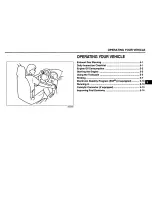
STARTING AND OPERATING
141
Battery Blanket Usage
A battery loses 60% of its cranking power as the
battery temperature decreases to 0°F (-18°C). For
the same decrease in temperature, the engine
requires twice as much power to crank at the same
RPM. The use of 120 Volt AC powered battery
blankets will greatly increase starting capability at
low temperatures. Suitable battery blankets are
available from an authorized Mopar® dealer.
Engine Warm-Up
Avoid full throttle operation when the engine is
cold. When starting a cold engine, bring the engine
up to operating speed slowly to allow the oil
pressure to stabilize as the engine warms up.
NOTE:
High-speed, no-load running of a cold engine can
result in excessive white smoke and poor engine
performance. No-load engine speeds should be
kept under 1,000 RPM during the warm-up period,
especially in cold ambient temperature conditions.
Your vehicle is equipped with an engine warm-up
protection feature that may limit engine
performance after cold starting at low ambient
temperatures. The length of time engine speed is
limited is dependent upon engine coolant
temperature. Engine speed may be briefly limited
to 1000 RPM after starting with coolant
temperature below freezing conditions, and may
be limited to 1000 RPM for up to approximately
two minutes under more severe cold conditions.
NOTE:
If ambient temperatures are low and the coolant
temperature is below 180°F (82°C), the engine
idle speed will slowly increase to 1,000 RPM after
two minutes of idle, if the following conditions are
met:
Foot is off brake pedal and throttle pedal.
Automatic transmission is in PARK.
Vehicle speed is 0 mph (0 km/h).
Applying the throttle will cancel fast idle.
Operating the exhaust brake at idle will greatly
improve warm-up rate and will help keep the
engine close to operating temperature during
extended idle.
E
NGINE
I
DLING
Avoid prolonged idling. Long periods of idling may
be harmful to your engine because combustion
chamber temperatures can drop so low that the
fuel may not burn completely. Incomplete
combustion allows carbon and varnish to form on
piston rings, engine valves, and injector nozzles.
Also, the unburned fuel can enter the crankcase,
diluting the oil and causing rapid wear to the
engine.
If the engine is allowed to idle or the truck is driven
on low engine speed drive cycles for more than two
hours, the system will automatically enter an
emissions operating mode that will increase the
engine idle speed to 900 RPM. While in this mode,
which is designed to help maintain the diesel
particulate filter, the engine idle speed will return
to normal when the brake pedal is applied. A small
change in engine tone or a slight change in engine
performance while accelerating may also be
noticeable at speeds below 20 mph (32 km/h).
This operating mode may last for up to an hour of
idle time, or around 20 minutes of driving time.
Your truck may have been ordered with an optional
voltage monitoring Idle-Up feature. If a load is
placed on the electrical system while the truck is in
park, this feature will attempt to maintain normal
system voltage by automatically increasing engine
idle speed. You may notice several consecutive
increases in idle speed, up to a maximum of
1,450 RPM, as the system will attempt to utilize
the smallest increase in idle speed necessary to
maintain normal system voltage. The idle speed
will return to normal when either the electrical load
is removed, or when the brake pedal is applied.
NOTE:
For instrument cluster display messages related to
the vehicle's exhaust system
Ú
page 109.
4
22_DJD2_OM_EN_USC_t.book Page 141
Summary of Contents for RAM 2500 2022
Page 1: ...2022 RAM 2500 3500 OWNER S MANUAL...
Page 10: ...2022 RAM 2500 3500 OWNER S MANUAL...
Page 492: ......
















































